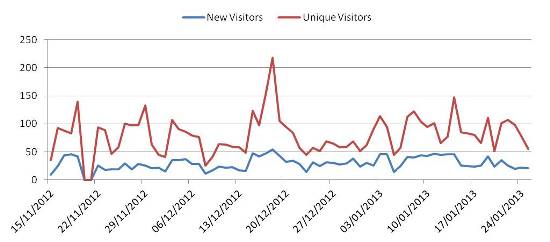Unique Visitors vs New Visitors in Google Analytics
I do not think it means what you think it means.
Inigo Montoya, from The Princess Bride
Sorry to piggyback off one of the classic lines from The Princess Bride, but sometimes your Google Analytics data does not mean what you think it means, as I found out from a real world example.
Recently, I was starting analysis for a new website, and found some strange results. Looking back from the launch of the website to the present day, there was a major discrepancy between the number of Unique Visitors and the number of New Visitors to the website.
I am well aware of the difference between the two metrics, and equally well aware that this is a common question that is asked on Google Analytics forums. The issue behind most of the questions has been answered many times, including on the Google Analytics blog. The crux of the problem, most of the time, is that a visitor can be counted as a unique visitor, but not a new visitor, if they have visited your website before the time period you are analyzing.
But, in this case, we were looking at the data from the launch of the website to the present. So, there was no such thing as visiting the site before the analysis period, and we would have expected the New Visitors to match with the Unique Visitors. But, as can be seen from the chart below, this was not the case. The number of Unique Visitors was much greater than the number of New Visitors.

My first instinct was to do an internet search for anyone that had seen this discrepancy. Although I found lots of references to a difference between the two, it always occurred for a given time range, or for a subset of pages. So, the internet was no help.
Finally, I managed to track down what was happening, and it had to do with how the site was set up, and how the tracking code was implemented on the site. The catch was that this was not a stand-alone site. It was a site that was a subset of a larger site. To complicate matters, when the analytics were set up, two trackers were placed on the pages of this subset – one for the master site (XXXXX-1) and one for the subset (XXXXX-2). So, every hit on the subset was actually being reported for two Analytics properties.
Now, here’s the catch and the crux of the problem. When Google Analytics checks for a New Visitor, it looks at the properties of the cookies on the site. And what it checks for is whether the root URL of the site matches the cookie. Since my subset had the same root URL as the master site, it was identifying people as return visitors even though it was their first visit to the subset.
So, if a visitor had been to the master site six months ago, and then came to the subset on the day of launch, they were being regarded as a Unique Visitor by Google Analytics, but not as a New Visitor. The only people that were New Visitors were those that had never been to the master site before coming to the subset of pages.
In the end, understanding how this metric was being counted in our particular case actually opened the door for a couple of measures involving interaction between the two parts of the site. But, it demonstrates how important it is to understand exactly how Google Analytics compiles data, and how sometimes the data is not exactly what you think it is.
Can we help with your SEO or Google Analytics? Contact us.